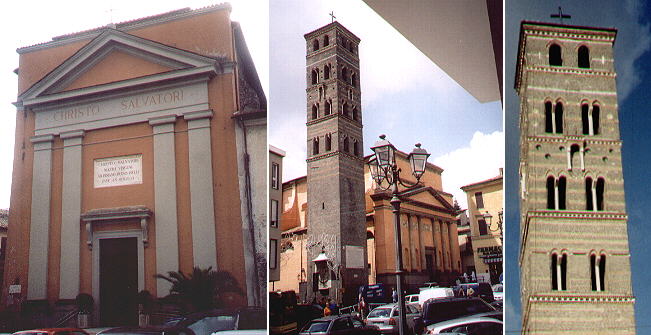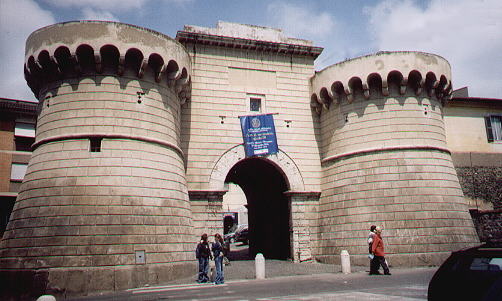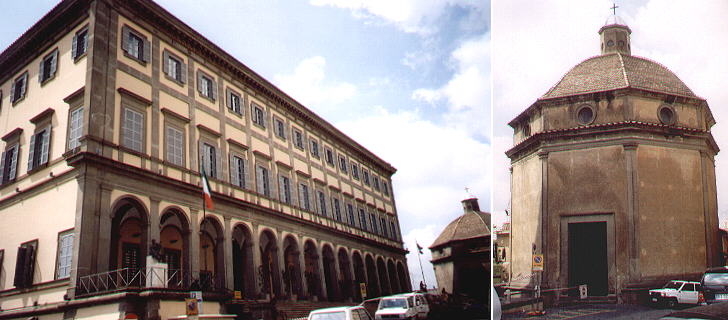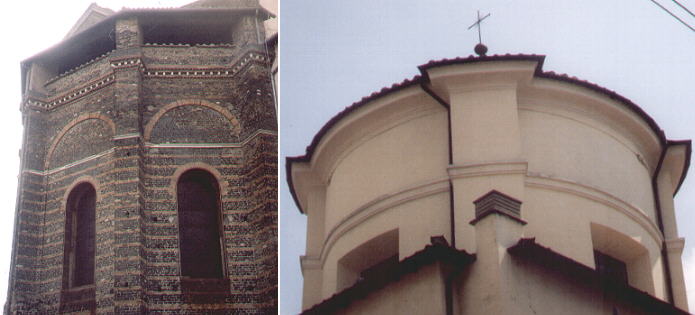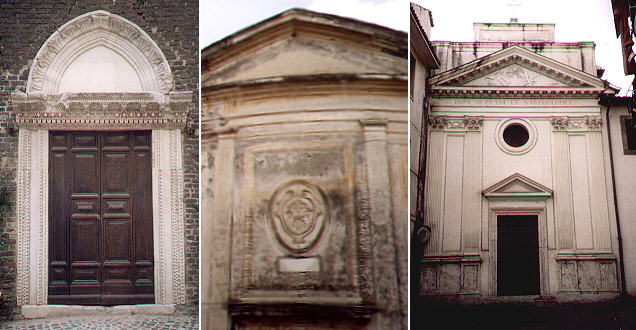

A visit to today's Velletri ought to start from Chiesa del Salvatore. Its Latin inscription explains what happened in Velletri between September 1943 and May 1944: "CHRISTO SALVATORI MATRI VIRGINI AB IMMANIS RUINIS BELLI INST. AN. MCMXLVI". In 1946 the church was completely
rebuilt after the enormous (IMMANIS) war damage. Velletri was particularly hit by the battle which followed the landing of the
Allies in Anzio and the number of homeless was so high that the town was hastily rebuilt to provide them with accommodation. In the process
little attention was paid to restoring its previous appearance.
Chiesa del Salvatore and Torre del Trivio
The main surviving monument of Velletri is a tall tower at the meeting point of three streets (It. trivio) and used
as the bell tower for the nearby church of S. Maria del Trivio which has a Neoclassic façade. The importance of Velletri grew with the attempts of the papal government
to reclaim the marshy land between the town and the sea. In 1850 it had approximately 12,000 inhabitants and it was the most important town of the Papal State south of Rome.
Porta Napoletana
Velletri was crossed by Via Appia: its northern gate (Porta Romana) is lost whilst the southern gate (Porta Napoletana),
although largely restored, is still in place.
Palazzo Municipale and S. Maria del Sangue
Velletri was renowned for two palaces: the large town hall designed by il Vignola and completed by Giacomo della Porta and Palazzo
Lancellotti or Ginnetti designed by Martino Longhi. They were both destroyed by war events, but the town hall was rebuilt
dov'era e come era (where and how it was). Next to the town hall there is a Renaissance oratory: its octagonal shape was typical of baptisteries.
Details of the Cathedral: apse and dome
The cathedral of Velletri was built over many centuries and it does not have a façade, but a lateral entrance flanked by two long porches. A coat of arms of the Della Rovere (used as a background image for this page) indicates that
Cardinal Giuliano della Rovere (Pope Julius II) contributed to the embellishment of the church.
S. Antonio, XVIIIth century oratory behind S. Lorenzo and SS. Pietro e Bartolomeo
Velletri offers a range of churches of different periods: the portal of the medieval church of S. Antonio is
decorated with pieces of the entablature of a Roman temple. An oratory behind S. Lorenzo shows the curved shape typical of Baroque architecture, while SS. Pietro e Bartolomeo has a Neoclassic façade.
Excerpts from Giuseppe Vasi 1761 Itinerary related to this page:
Città di Velletri
Sulla medesima strada 24. miglia lungi da Roma è questa insigne città, la quale fu la metropoli e capo de' Volschi, ed e illustre per il nascimento
della famiglia Ottavia Augusta; perciò Ottaviano vi ebbe delle delizie, come ancora Tiberio, Nerva, Cajo Caligola, e Ottone, delle quali ancor
oggidì se ne vedono li vestigj. Ma lasciate le profane memorie, si crede, che quì s. Pietro nella seconda volta, che venne da Gerusalemme a
Roma, o pure s. Paolo nel passare, che fece da questa città, vi spargesse la parola evangelica; ma con più probabilità si presume ciò di
s. Clemente oriundo da Velletri, per avergli i Velletrani dedicato dopo il di lui martirio il più magnifico tempio, che avevano, eretto a Marte,
che oggidì è la chiesa cattedrale, alla quale fu poi da Eugenio III. unita, come diremo, quella di Ostia. E' riguardevole in questa città il
palazzo Ginnetti, colla magnifica scala tutta di candidi marmi, e la statua di metallo eretta nella piazza ad Urbano VIII. per benemerenza
da quel popolo.
|
Next step in your tour of the Environs of Rome: Albano
See my Home Page on Baroque Rome or my
Home Page on Rome in the footsteps of an
XVIIIth century traveller.
|


